Leadership and Management: Roles, Functions, Theories, and Tesco
VerifiedAdded on 2020/07/22
|19
|5824
|32
Report
AI Summary
This report delves into the core distinctions between leaders and managers, outlining their respective roles and functions within an organizational context. It contrasts the traits of effective leaders, such as vision setting and motivation, with the operational focus of managers, emphasizing planning, organizing, and controlling. The report explores various leadership theories, including skill theory and situational theory, providing a comprehensive overview of different leadership styles. Furthermore, it analyzes the significance of operations management in achieving business objectives, considering the impact of the business environment on operational decision-making. The report uses Tesco as a case study to demonstrate how leadership and management principles are applied in a real-world multinational organization, highlighting the practical implications of these concepts.
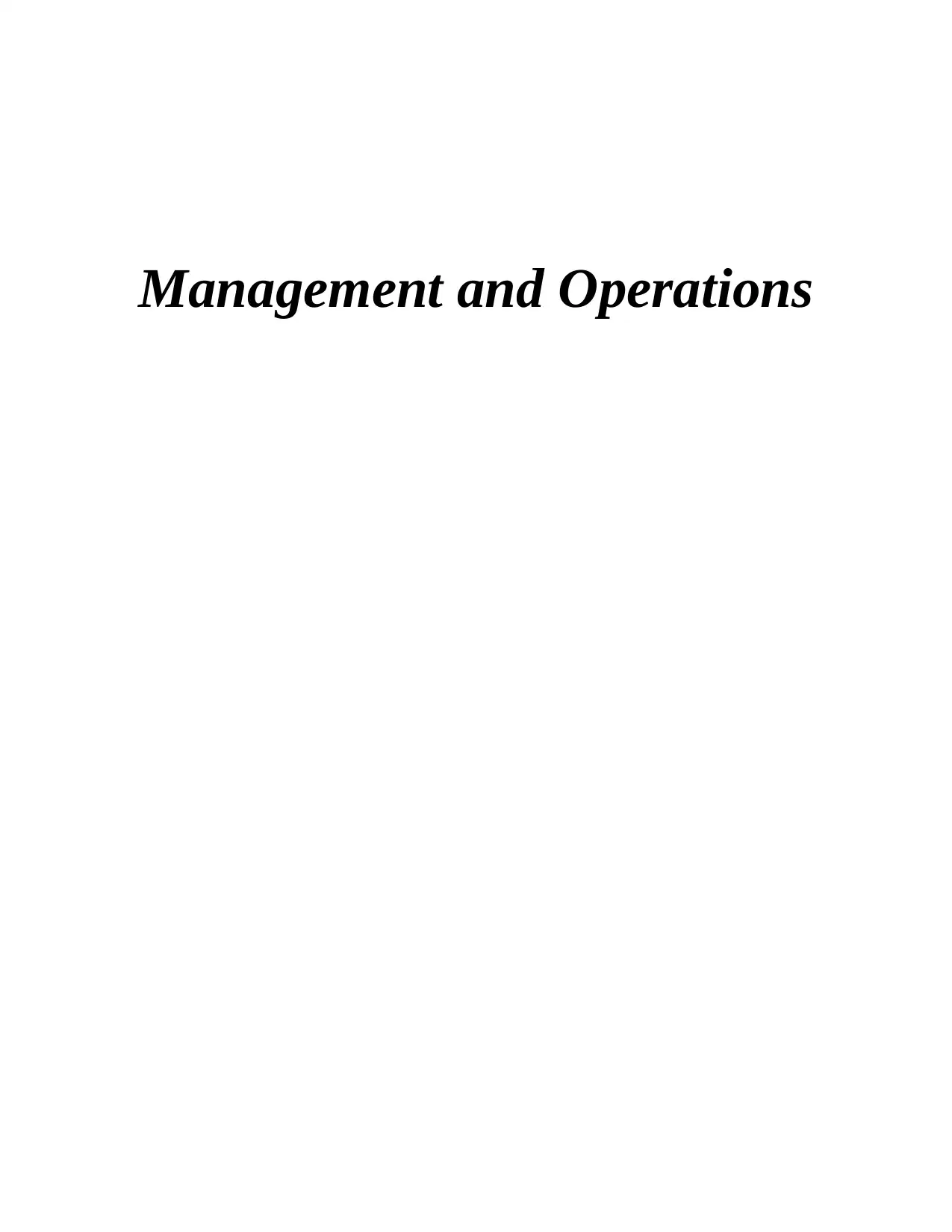
Management and Operations
Paraphrase This Document
Need a fresh take? Get an instant paraphrase of this document with our AI Paraphraser
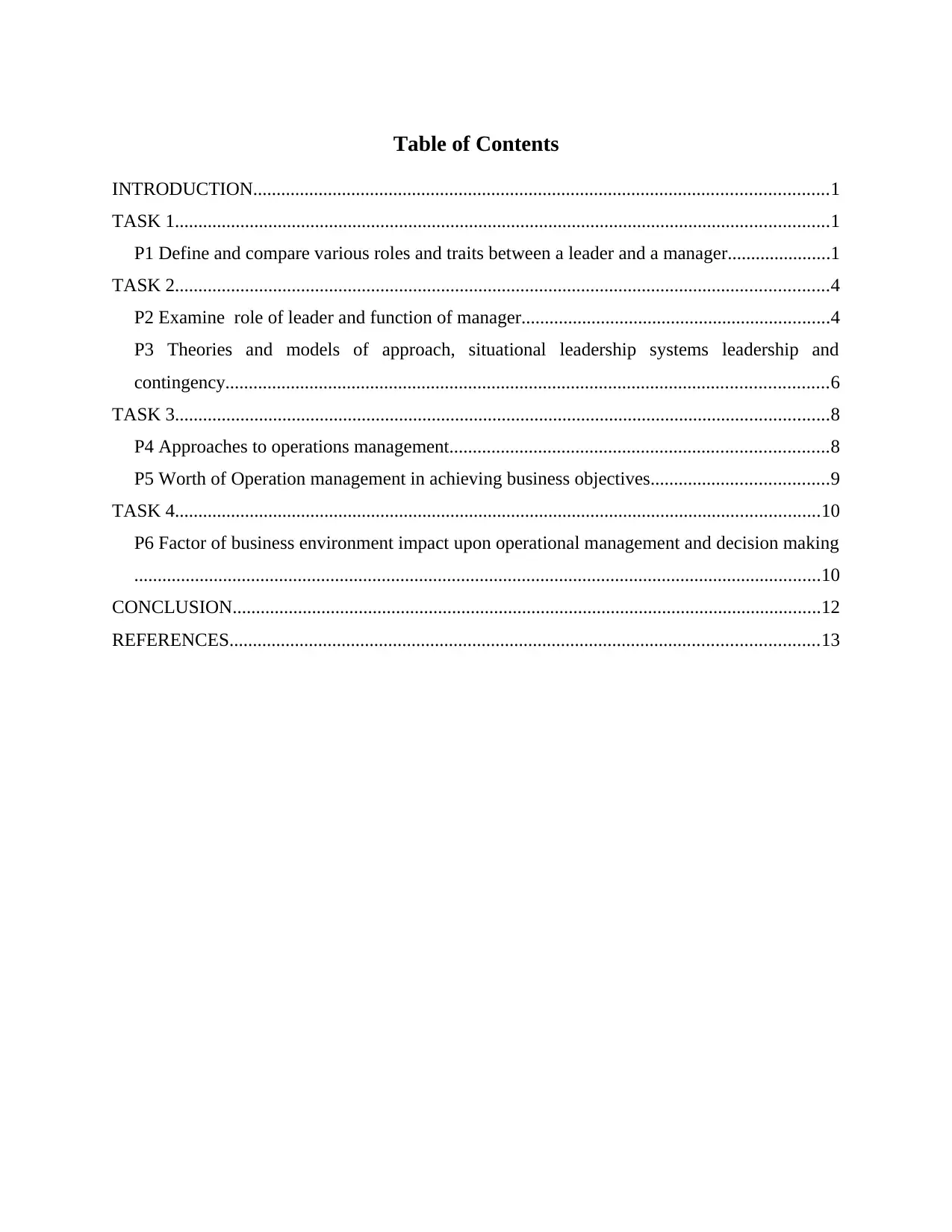
Table of Contents
INTRODUCTION...........................................................................................................................1
TASK 1............................................................................................................................................1
P1 Define and compare various roles and traits between a leader and a manager......................1
TASK 2............................................................................................................................................4
P2 Examine role of leader and function of manager..................................................................4
P3 Theories and models of approach, situational leadership systems leadership and
contingency.................................................................................................................................6
TASK 3............................................................................................................................................8
P4 Approaches to operations management.................................................................................8
P5 Worth of Operation management in achieving business objectives......................................9
TASK 4..........................................................................................................................................10
P6 Factor of business environment impact upon operational management and decision making
...................................................................................................................................................10
CONCLUSION..............................................................................................................................12
REFERENCES..............................................................................................................................13
INTRODUCTION...........................................................................................................................1
TASK 1............................................................................................................................................1
P1 Define and compare various roles and traits between a leader and a manager......................1
TASK 2............................................................................................................................................4
P2 Examine role of leader and function of manager..................................................................4
P3 Theories and models of approach, situational leadership systems leadership and
contingency.................................................................................................................................6
TASK 3............................................................................................................................................8
P4 Approaches to operations management.................................................................................8
P5 Worth of Operation management in achieving business objectives......................................9
TASK 4..........................................................................................................................................10
P6 Factor of business environment impact upon operational management and decision making
...................................................................................................................................................10
CONCLUSION..............................................................................................................................12
REFERENCES..............................................................................................................................13
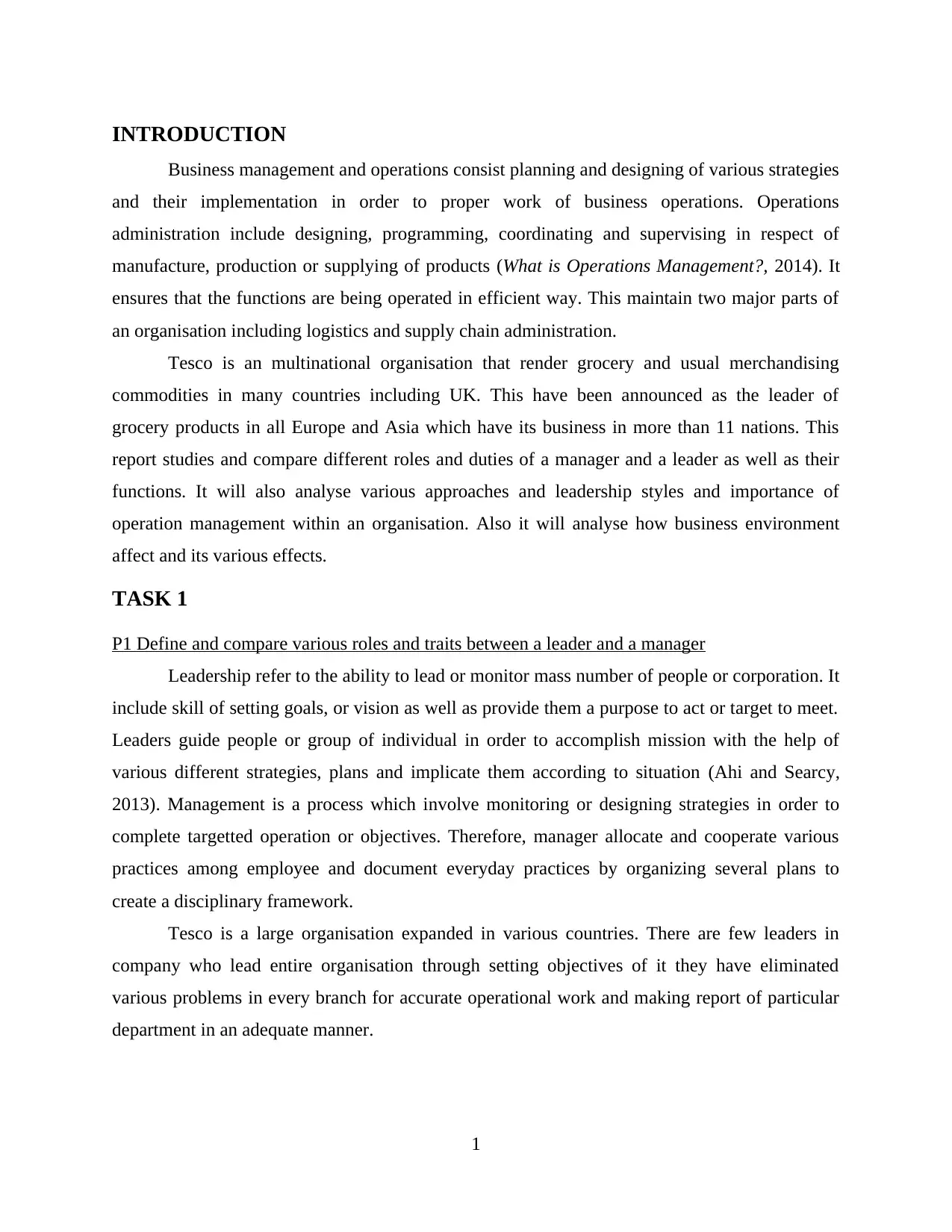
INTRODUCTION
Business management and operations consist planning and designing of various strategies
and their implementation in order to proper work of business operations. Operations
administration include designing, programming, coordinating and supervising in respect of
manufacture, production or supplying of products (What is Operations Management?, 2014). It
ensures that the functions are being operated in efficient way. This maintain two major parts of
an organisation including logistics and supply chain administration.
Tesco is an multinational organisation that render grocery and usual merchandising
commodities in many countries including UK. This have been announced as the leader of
grocery products in all Europe and Asia which have its business in more than 11 nations. This
report studies and compare different roles and duties of a manager and a leader as well as their
functions. It will also analyse various approaches and leadership styles and importance of
operation management within an organisation. Also it will analyse how business environment
affect and its various effects.
TASK 1
P1 Define and compare various roles and traits between a leader and a manager
Leadership refer to the ability to lead or monitor mass number of people or corporation. It
include skill of setting goals, or vision as well as provide them a purpose to act or target to meet.
Leaders guide people or group of individual in order to accomplish mission with the help of
various different strategies, plans and implicate them according to situation (Ahi and Searcy,
2013). Management is a process which involve monitoring or designing strategies in order to
complete targetted operation or objectives. Therefore, manager allocate and cooperate various
practices among employee and document everyday practices by organizing several plans to
create a disciplinary framework.
Tesco is a large organisation expanded in various countries. There are few leaders in
company who lead entire organisation through setting objectives of it they have eliminated
various problems in every branch for accurate operational work and making report of particular
department in an adequate manner.
1
Business management and operations consist planning and designing of various strategies
and their implementation in order to proper work of business operations. Operations
administration include designing, programming, coordinating and supervising in respect of
manufacture, production or supplying of products (What is Operations Management?, 2014). It
ensures that the functions are being operated in efficient way. This maintain two major parts of
an organisation including logistics and supply chain administration.
Tesco is an multinational organisation that render grocery and usual merchandising
commodities in many countries including UK. This have been announced as the leader of
grocery products in all Europe and Asia which have its business in more than 11 nations. This
report studies and compare different roles and duties of a manager and a leader as well as their
functions. It will also analyse various approaches and leadership styles and importance of
operation management within an organisation. Also it will analyse how business environment
affect and its various effects.
TASK 1
P1 Define and compare various roles and traits between a leader and a manager
Leadership refer to the ability to lead or monitor mass number of people or corporation. It
include skill of setting goals, or vision as well as provide them a purpose to act or target to meet.
Leaders guide people or group of individual in order to accomplish mission with the help of
various different strategies, plans and implicate them according to situation (Ahi and Searcy,
2013). Management is a process which involve monitoring or designing strategies in order to
complete targetted operation or objectives. Therefore, manager allocate and cooperate various
practices among employee and document everyday practices by organizing several plans to
create a disciplinary framework.
Tesco is a large organisation expanded in various countries. There are few leaders in
company who lead entire organisation through setting objectives of it they have eliminated
various problems in every branch for accurate operational work and making report of particular
department in an adequate manner.
1
⊘ This is a preview!⊘
Do you want full access?
Subscribe today to unlock all pages.

Trusted by 1+ million students worldwide
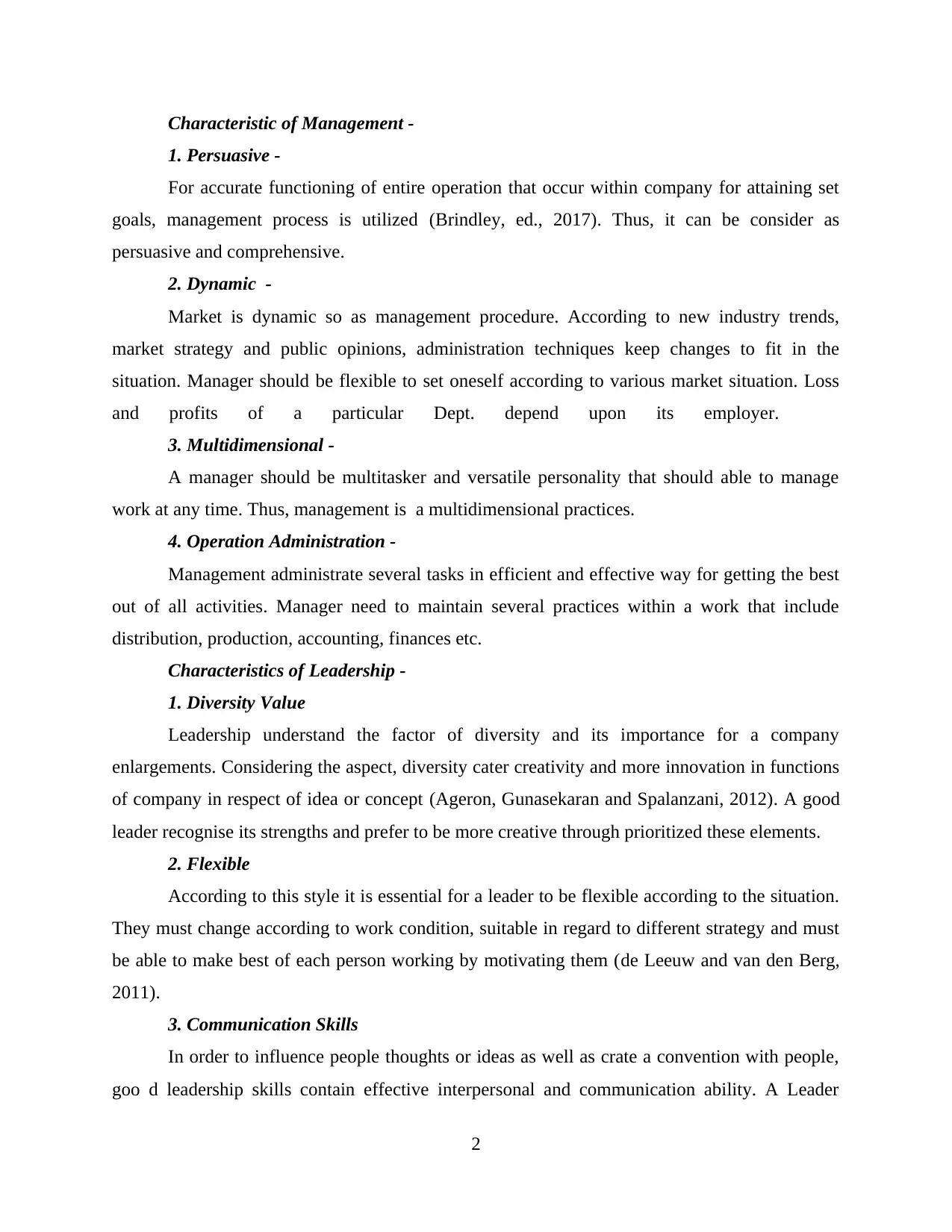
Characteristic of Management -
1. Persuasive -
For accurate functioning of entire operation that occur within company for attaining set
goals, management process is utilized (Brindley, ed., 2017). Thus, it can be consider as
persuasive and comprehensive.
2. Dynamic -
Market is dynamic so as management procedure. According to new industry trends,
market strategy and public opinions, administration techniques keep changes to fit in the
situation. Manager should be flexible to set oneself according to various market situation. Loss
and profits of a particular Dept. depend upon its employer.
3. Multidimensional -
A manager should be multitasker and versatile personality that should able to manage
work at any time. Thus, management is a multidimensional practices.
4. Operation Administration -
Management administrate several tasks in efficient and effective way for getting the best
out of all activities. Manager need to maintain several practices within a work that include
distribution, production, accounting, finances etc.
Characteristics of Leadership -
1. Diversity Value
Leadership understand the factor of diversity and its importance for a company
enlargements. Considering the aspect, diversity cater creativity and more innovation in functions
of company in respect of idea or concept (Ageron, Gunasekaran and Spalanzani, 2012). A good
leader recognise its strengths and prefer to be more creative through prioritized these elements.
2. Flexible
According to this style it is essential for a leader to be flexible according to the situation.
They must change according to work condition, suitable in regard to different strategy and must
be able to make best of each person working by motivating them (de Leeuw and van den Berg,
2011).
3. Communication Skills
In order to influence people thoughts or ideas as well as crate a convention with people,
goo d leadership skills contain effective interpersonal and communication ability. A Leader
2
1. Persuasive -
For accurate functioning of entire operation that occur within company for attaining set
goals, management process is utilized (Brindley, ed., 2017). Thus, it can be consider as
persuasive and comprehensive.
2. Dynamic -
Market is dynamic so as management procedure. According to new industry trends,
market strategy and public opinions, administration techniques keep changes to fit in the
situation. Manager should be flexible to set oneself according to various market situation. Loss
and profits of a particular Dept. depend upon its employer.
3. Multidimensional -
A manager should be multitasker and versatile personality that should able to manage
work at any time. Thus, management is a multidimensional practices.
4. Operation Administration -
Management administrate several tasks in efficient and effective way for getting the best
out of all activities. Manager need to maintain several practices within a work that include
distribution, production, accounting, finances etc.
Characteristics of Leadership -
1. Diversity Value
Leadership understand the factor of diversity and its importance for a company
enlargements. Considering the aspect, diversity cater creativity and more innovation in functions
of company in respect of idea or concept (Ageron, Gunasekaran and Spalanzani, 2012). A good
leader recognise its strengths and prefer to be more creative through prioritized these elements.
2. Flexible
According to this style it is essential for a leader to be flexible according to the situation.
They must change according to work condition, suitable in regard to different strategy and must
be able to make best of each person working by motivating them (de Leeuw and van den Berg,
2011).
3. Communication Skills
In order to influence people thoughts or ideas as well as crate a convention with people,
goo d leadership skills contain effective interpersonal and communication ability. A Leader
2
Paraphrase This Document
Need a fresh take? Get an instant paraphrase of this document with our AI Paraphraser
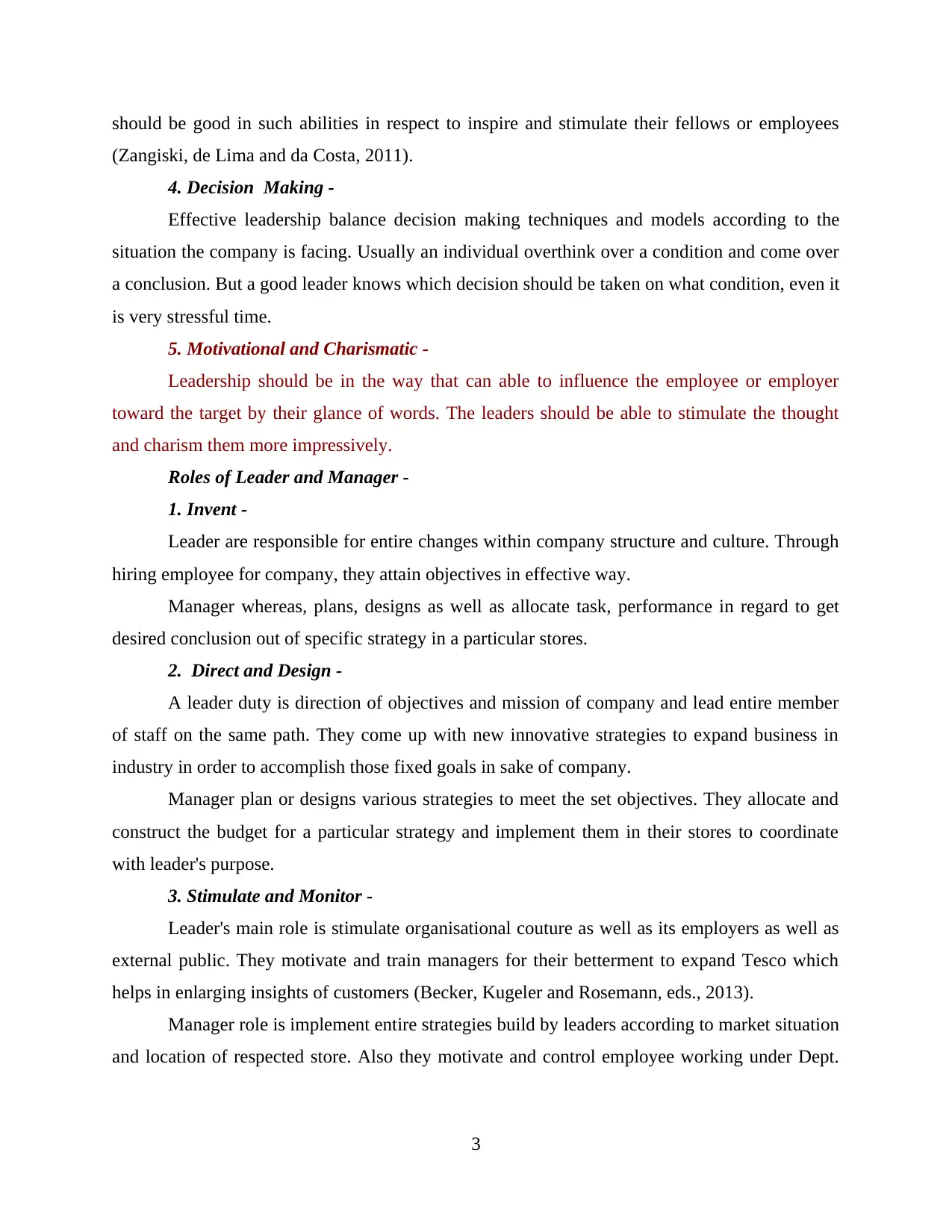
should be good in such abilities in respect to inspire and stimulate their fellows or employees
(Zangiski, de Lima and da Costa, 2011).
4. Decision Making -
Effective leadership balance decision making techniques and models according to the
situation the company is facing. Usually an individual overthink over a condition and come over
a conclusion. But a good leader knows which decision should be taken on what condition, even it
is very stressful time.
5. Motivational and Charismatic -
Leadership should be in the way that can able to influence the employee or employer
toward the target by their glance of words. The leaders should be able to stimulate the thought
and charism them more impressively.
Roles of Leader and Manager -
1. Invent -
Leader are responsible for entire changes within company structure and culture. Through
hiring employee for company, they attain objectives in effective way.
Manager whereas, plans, designs as well as allocate task, performance in regard to get
desired conclusion out of specific strategy in a particular stores.
2. Direct and Design -
A leader duty is direction of objectives and mission of company and lead entire member
of staff on the same path. They come up with new innovative strategies to expand business in
industry in order to accomplish those fixed goals in sake of company.
Manager plan or designs various strategies to meet the set objectives. They allocate and
construct the budget for a particular strategy and implement them in their stores to coordinate
with leader's purpose.
3. Stimulate and Monitor -
Leader's main role is stimulate organisational couture as well as its employers as well as
external public. They motivate and train managers for their betterment to expand Tesco which
helps in enlarging insights of customers (Becker, Kugeler and Rosemann, eds., 2013).
Manager role is implement entire strategies build by leaders according to market situation
and location of respected store. Also they motivate and control employee working under Dept.
3
(Zangiski, de Lima and da Costa, 2011).
4. Decision Making -
Effective leadership balance decision making techniques and models according to the
situation the company is facing. Usually an individual overthink over a condition and come over
a conclusion. But a good leader knows which decision should be taken on what condition, even it
is very stressful time.
5. Motivational and Charismatic -
Leadership should be in the way that can able to influence the employee or employer
toward the target by their glance of words. The leaders should be able to stimulate the thought
and charism them more impressively.
Roles of Leader and Manager -
1. Invent -
Leader are responsible for entire changes within company structure and culture. Through
hiring employee for company, they attain objectives in effective way.
Manager whereas, plans, designs as well as allocate task, performance in regard to get
desired conclusion out of specific strategy in a particular stores.
2. Direct and Design -
A leader duty is direction of objectives and mission of company and lead entire member
of staff on the same path. They come up with new innovative strategies to expand business in
industry in order to accomplish those fixed goals in sake of company.
Manager plan or designs various strategies to meet the set objectives. They allocate and
construct the budget for a particular strategy and implement them in their stores to coordinate
with leader's purpose.
3. Stimulate and Monitor -
Leader's main role is stimulate organisational couture as well as its employers as well as
external public. They motivate and train managers for their betterment to expand Tesco which
helps in enlarging insights of customers (Becker, Kugeler and Rosemann, eds., 2013).
Manager role is implement entire strategies build by leaders according to market situation
and location of respected store. Also they motivate and control employee working under Dept.
3
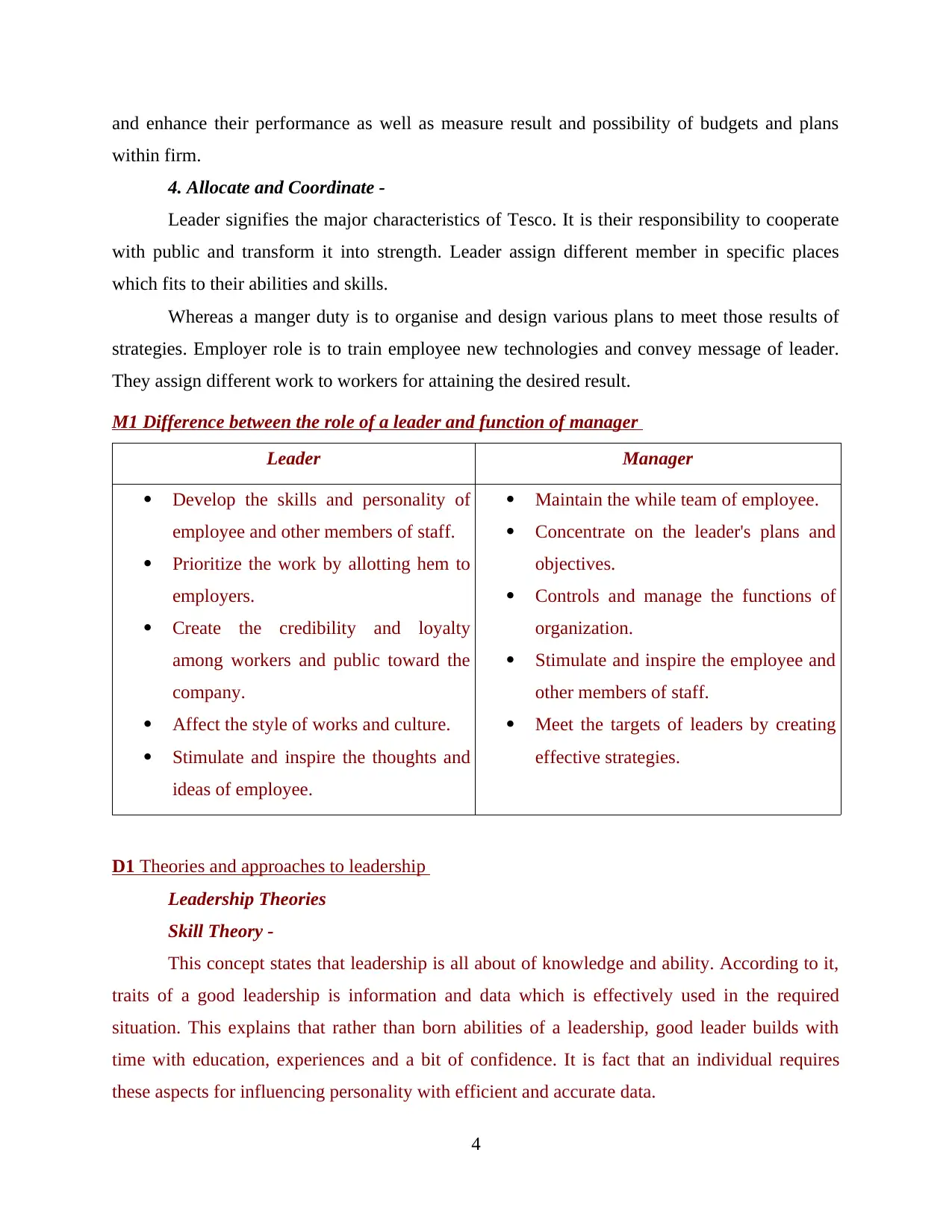
and enhance their performance as well as measure result and possibility of budgets and plans
within firm.
4. Allocate and Coordinate -
Leader signifies the major characteristics of Tesco. It is their responsibility to cooperate
with public and transform it into strength. Leader assign different member in specific places
which fits to their abilities and skills.
Whereas a manger duty is to organise and design various plans to meet those results of
strategies. Employer role is to train employee new technologies and convey message of leader.
They assign different work to workers for attaining the desired result.
M1 Difference between the role of a leader and function of manager
Leader Manager
Develop the skills and personality of
employee and other members of staff.
Prioritize the work by allotting hem to
employers.
Create the credibility and loyalty
among workers and public toward the
company.
Affect the style of works and culture.
Stimulate and inspire the thoughts and
ideas of employee.
Maintain the while team of employee.
Concentrate on the leader's plans and
objectives.
Controls and manage the functions of
organization.
Stimulate and inspire the employee and
other members of staff.
Meet the targets of leaders by creating
effective strategies.
D1 Theories and approaches to leadership
Leadership Theories
Skill Theory -
This concept states that leadership is all about of knowledge and ability. According to it,
traits of a good leadership is information and data which is effectively used in the required
situation. This explains that rather than born abilities of a leadership, good leader builds with
time with education, experiences and a bit of confidence. It is fact that an individual requires
these aspects for influencing personality with efficient and accurate data.
4
within firm.
4. Allocate and Coordinate -
Leader signifies the major characteristics of Tesco. It is their responsibility to cooperate
with public and transform it into strength. Leader assign different member in specific places
which fits to their abilities and skills.
Whereas a manger duty is to organise and design various plans to meet those results of
strategies. Employer role is to train employee new technologies and convey message of leader.
They assign different work to workers for attaining the desired result.
M1 Difference between the role of a leader and function of manager
Leader Manager
Develop the skills and personality of
employee and other members of staff.
Prioritize the work by allotting hem to
employers.
Create the credibility and loyalty
among workers and public toward the
company.
Affect the style of works and culture.
Stimulate and inspire the thoughts and
ideas of employee.
Maintain the while team of employee.
Concentrate on the leader's plans and
objectives.
Controls and manage the functions of
organization.
Stimulate and inspire the employee and
other members of staff.
Meet the targets of leaders by creating
effective strategies.
D1 Theories and approaches to leadership
Leadership Theories
Skill Theory -
This concept states that leadership is all about of knowledge and ability. According to it,
traits of a good leadership is information and data which is effectively used in the required
situation. This explains that rather than born abilities of a leadership, good leader builds with
time with education, experiences and a bit of confidence. It is fact that an individual requires
these aspects for influencing personality with efficient and accurate data.
4
⊘ This is a preview!⊘
Do you want full access?
Subscribe today to unlock all pages.

Trusted by 1+ million students worldwide
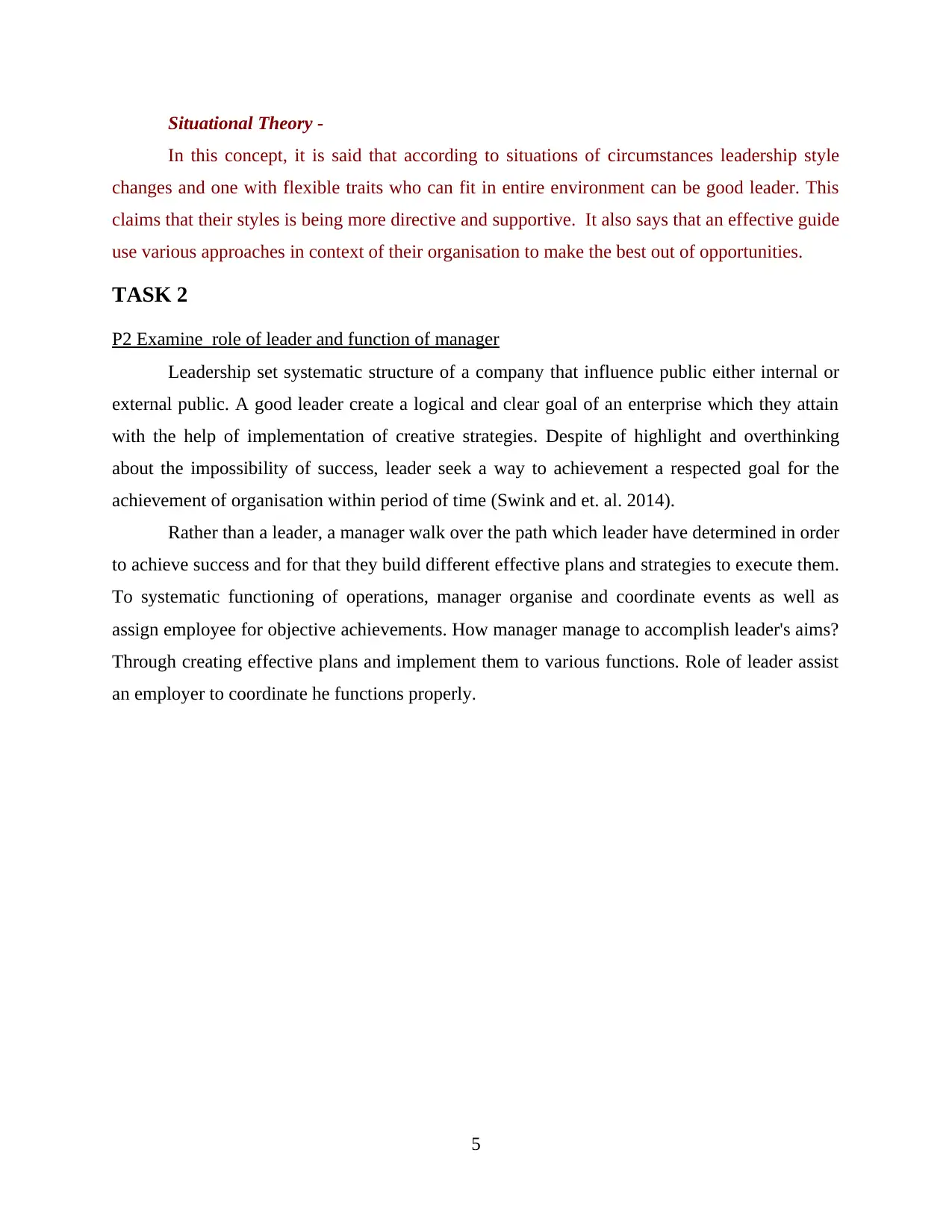
Situational Theory -
In this concept, it is said that according to situations of circumstances leadership style
changes and one with flexible traits who can fit in entire environment can be good leader. This
claims that their styles is being more directive and supportive. It also says that an effective guide
use various approaches in context of their organisation to make the best out of opportunities.
TASK 2
P2 Examine role of leader and function of manager
Leadership set systematic structure of a company that influence public either internal or
external public. A good leader create a logical and clear goal of an enterprise which they attain
with the help of implementation of creative strategies. Despite of highlight and overthinking
about the impossibility of success, leader seek a way to achievement a respected goal for the
achievement of organisation within period of time (Swink and et. al. 2014).
Rather than a leader, a manager walk over the path which leader have determined in order
to achieve success and for that they build different effective plans and strategies to execute them.
To systematic functioning of operations, manager organise and coordinate events as well as
assign employee for objective achievements. How manager manage to accomplish leader's aims?
Through creating effective plans and implement them to various functions. Role of leader assist
an employer to coordinate he functions properly.
5
In this concept, it is said that according to situations of circumstances leadership style
changes and one with flexible traits who can fit in entire environment can be good leader. This
claims that their styles is being more directive and supportive. It also says that an effective guide
use various approaches in context of their organisation to make the best out of opportunities.
TASK 2
P2 Examine role of leader and function of manager
Leadership set systematic structure of a company that influence public either internal or
external public. A good leader create a logical and clear goal of an enterprise which they attain
with the help of implementation of creative strategies. Despite of highlight and overthinking
about the impossibility of success, leader seek a way to achievement a respected goal for the
achievement of organisation within period of time (Swink and et. al. 2014).
Rather than a leader, a manager walk over the path which leader have determined in order
to achieve success and for that they build different effective plans and strategies to execute them.
To systematic functioning of operations, manager organise and coordinate events as well as
assign employee for objective achievements. How manager manage to accomplish leader's aims?
Through creating effective plans and implement them to various functions. Role of leader assist
an employer to coordinate he functions properly.
5
Paraphrase This Document
Need a fresh take? Get an instant paraphrase of this document with our AI Paraphraser
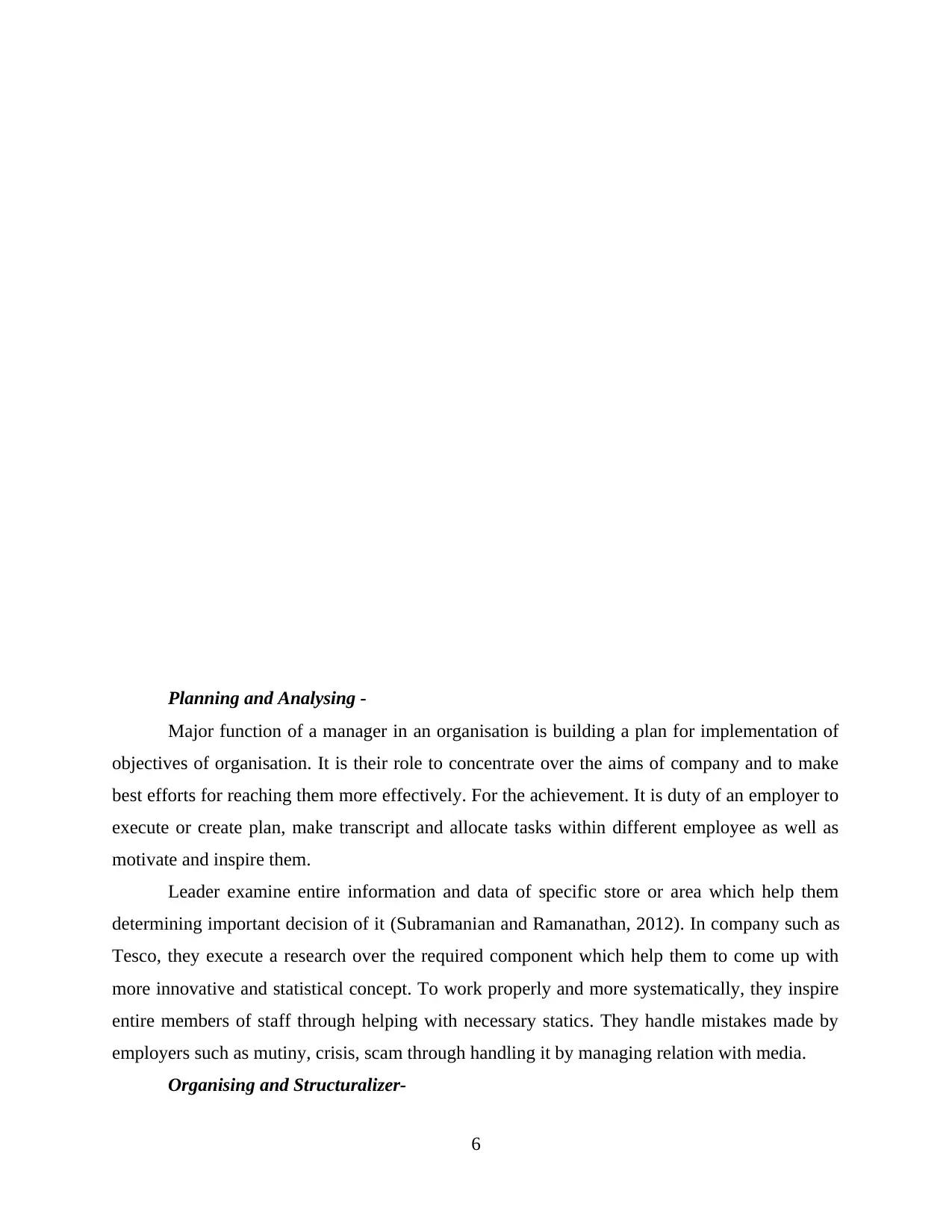
Planning and Analysing -
Major function of a manager in an organisation is building a plan for implementation of
objectives of organisation. It is their role to concentrate over the aims of company and to make
best efforts for reaching them more effectively. For the achievement. It is duty of an employer to
execute or create plan, make transcript and allocate tasks within different employee as well as
motivate and inspire them.
Leader examine entire information and data of specific store or area which help them
determining important decision of it (Subramanian and Ramanathan, 2012). In company such as
Tesco, they execute a research over the required component which help them to come up with
more innovative and statistical concept. To work properly and more systematically, they inspire
entire members of staff through helping with necessary statics. They handle mistakes made by
employers such as mutiny, crisis, scam through handling it by managing relation with media.
Organising and Structuralizer-
6
Major function of a manager in an organisation is building a plan for implementation of
objectives of organisation. It is their role to concentrate over the aims of company and to make
best efforts for reaching them more effectively. For the achievement. It is duty of an employer to
execute or create plan, make transcript and allocate tasks within different employee as well as
motivate and inspire them.
Leader examine entire information and data of specific store or area which help them
determining important decision of it (Subramanian and Ramanathan, 2012). In company such as
Tesco, they execute a research over the required component which help them to come up with
more innovative and statistical concept. To work properly and more systematically, they inspire
entire members of staff through helping with necessary statics. They handle mistakes made by
employers such as mutiny, crisis, scam through handling it by managing relation with media.
Organising and Structuralizer-
6
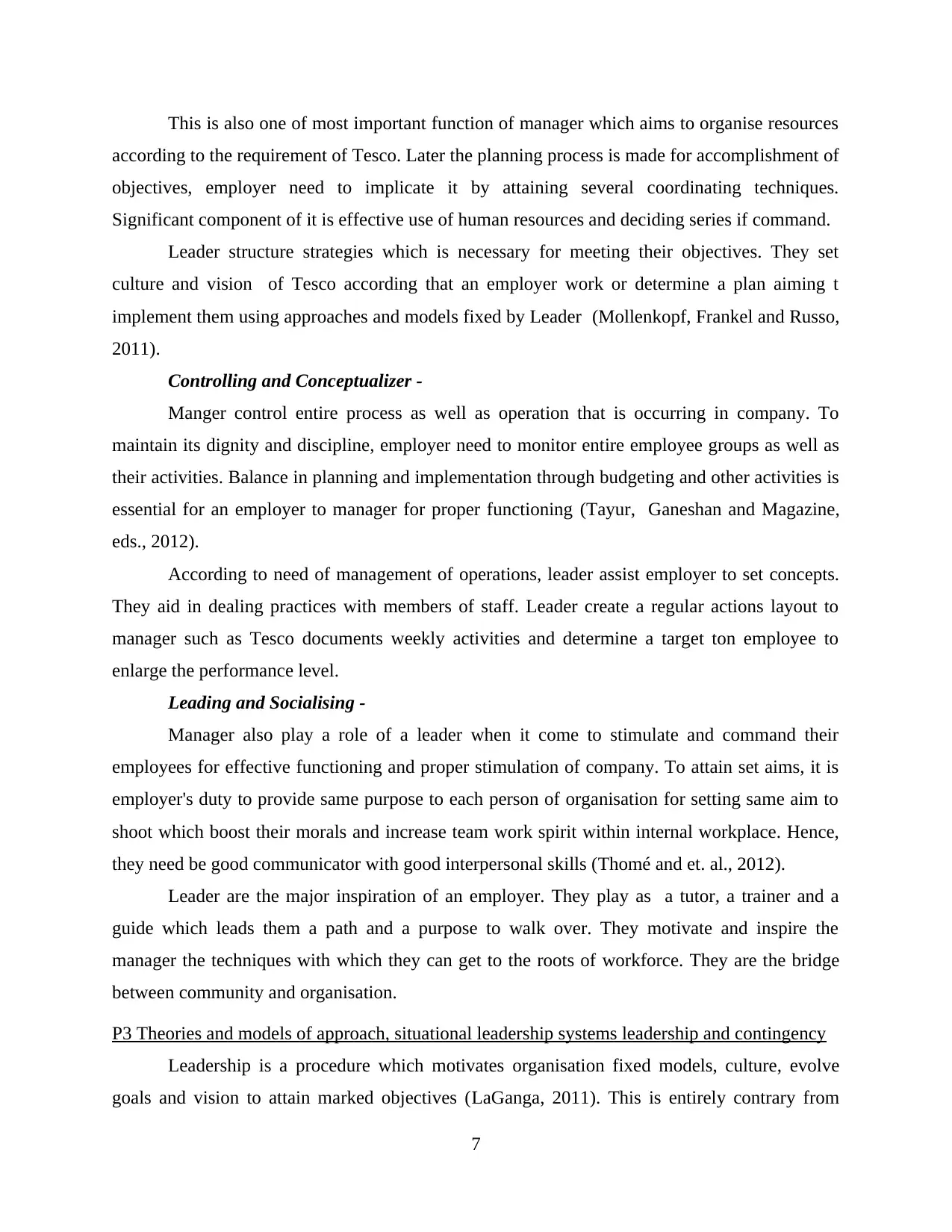
This is also one of most important function of manager which aims to organise resources
according to the requirement of Tesco. Later the planning process is made for accomplishment of
objectives, employer need to implicate it by attaining several coordinating techniques.
Significant component of it is effective use of human resources and deciding series if command.
Leader structure strategies which is necessary for meeting their objectives. They set
culture and vision of Tesco according that an employer work or determine a plan aiming t
implement them using approaches and models fixed by Leader (Mollenkopf, Frankel and Russo,
2011).
Controlling and Conceptualizer -
Manger control entire process as well as operation that is occurring in company. To
maintain its dignity and discipline, employer need to monitor entire employee groups as well as
their activities. Balance in planning and implementation through budgeting and other activities is
essential for an employer to manager for proper functioning (Tayur, Ganeshan and Magazine,
eds., 2012).
According to need of management of operations, leader assist employer to set concepts.
They aid in dealing practices with members of staff. Leader create a regular actions layout to
manager such as Tesco documents weekly activities and determine a target ton employee to
enlarge the performance level.
Leading and Socialising -
Manager also play a role of a leader when it come to stimulate and command their
employees for effective functioning and proper stimulation of company. To attain set aims, it is
employer's duty to provide same purpose to each person of organisation for setting same aim to
shoot which boost their morals and increase team work spirit within internal workplace. Hence,
they need be good communicator with good interpersonal skills (Thomé and et. al., 2012).
Leader are the major inspiration of an employer. They play as a tutor, a trainer and a
guide which leads them a path and a purpose to walk over. They motivate and inspire the
manager the techniques with which they can get to the roots of workforce. They are the bridge
between community and organisation.
P3 Theories and models of approach, situational leadership systems leadership and contingency
Leadership is a procedure which motivates organisation fixed models, culture, evolve
goals and vision to attain marked objectives (LaGanga, 2011). This is entirely contrary from
7
according to the requirement of Tesco. Later the planning process is made for accomplishment of
objectives, employer need to implicate it by attaining several coordinating techniques.
Significant component of it is effective use of human resources and deciding series if command.
Leader structure strategies which is necessary for meeting their objectives. They set
culture and vision of Tesco according that an employer work or determine a plan aiming t
implement them using approaches and models fixed by Leader (Mollenkopf, Frankel and Russo,
2011).
Controlling and Conceptualizer -
Manger control entire process as well as operation that is occurring in company. To
maintain its dignity and discipline, employer need to monitor entire employee groups as well as
their activities. Balance in planning and implementation through budgeting and other activities is
essential for an employer to manager for proper functioning (Tayur, Ganeshan and Magazine,
eds., 2012).
According to need of management of operations, leader assist employer to set concepts.
They aid in dealing practices with members of staff. Leader create a regular actions layout to
manager such as Tesco documents weekly activities and determine a target ton employee to
enlarge the performance level.
Leading and Socialising -
Manager also play a role of a leader when it come to stimulate and command their
employees for effective functioning and proper stimulation of company. To attain set aims, it is
employer's duty to provide same purpose to each person of organisation for setting same aim to
shoot which boost their morals and increase team work spirit within internal workplace. Hence,
they need be good communicator with good interpersonal skills (Thomé and et. al., 2012).
Leader are the major inspiration of an employer. They play as a tutor, a trainer and a
guide which leads them a path and a purpose to walk over. They motivate and inspire the
manager the techniques with which they can get to the roots of workforce. They are the bridge
between community and organisation.
P3 Theories and models of approach, situational leadership systems leadership and contingency
Leadership is a procedure which motivates organisation fixed models, culture, evolve
goals and vision to attain marked objectives (LaGanga, 2011). This is entirely contrary from
7
⊘ This is a preview!⊘
Do you want full access?
Subscribe today to unlock all pages.

Trusted by 1+ million students worldwide
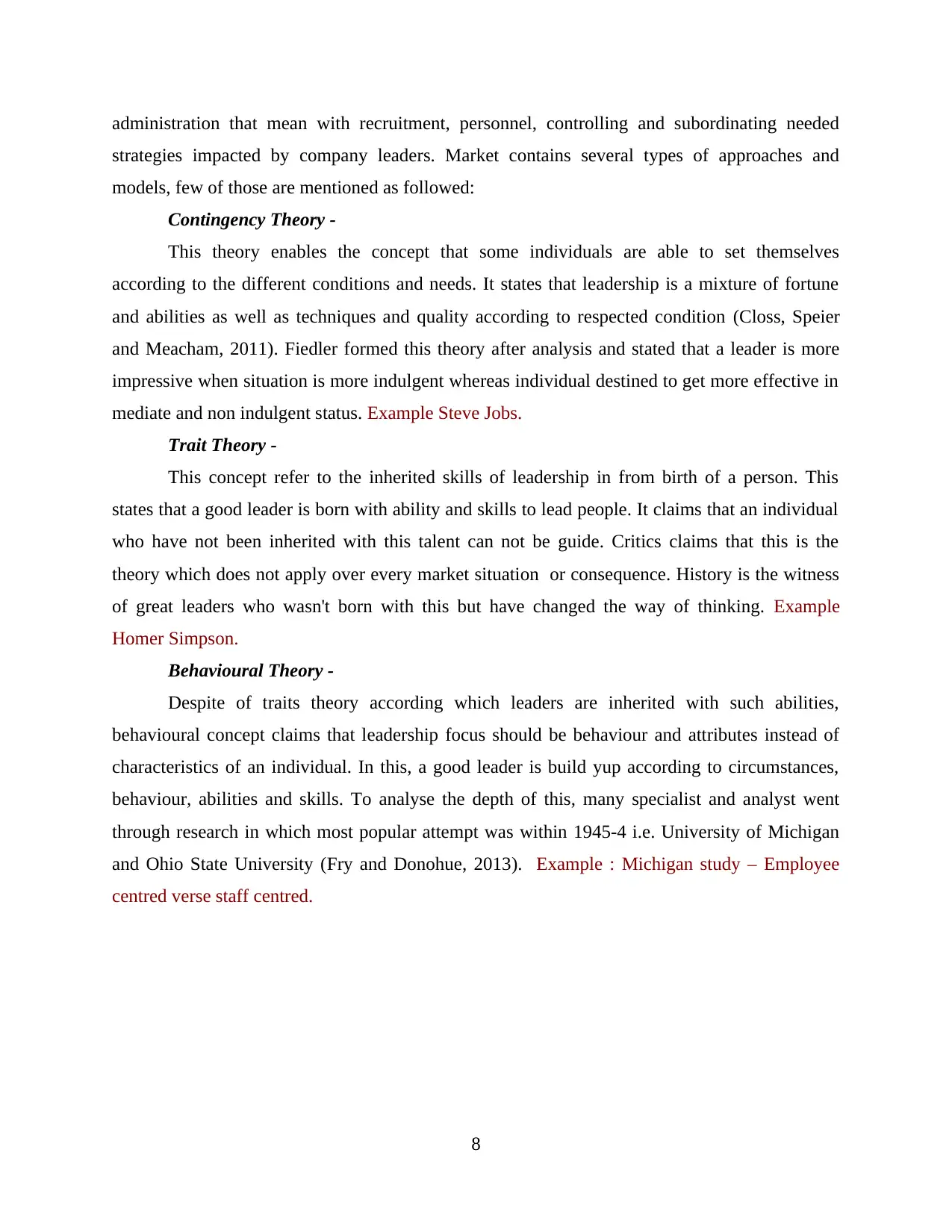
administration that mean with recruitment, personnel, controlling and subordinating needed
strategies impacted by company leaders. Market contains several types of approaches and
models, few of those are mentioned as followed:
Contingency Theory -
This theory enables the concept that some individuals are able to set themselves
according to the different conditions and needs. It states that leadership is a mixture of fortune
and abilities as well as techniques and quality according to respected condition (Closs, Speier
and Meacham, 2011). Fiedler formed this theory after analysis and stated that a leader is more
impressive when situation is more indulgent whereas individual destined to get more effective in
mediate and non indulgent status. Example Steve Jobs.
Trait Theory -
This concept refer to the inherited skills of leadership in from birth of a person. This
states that a good leader is born with ability and skills to lead people. It claims that an individual
who have not been inherited with this talent can not be guide. Critics claims that this is the
theory which does not apply over every market situation or consequence. History is the witness
of great leaders who wasn't born with this but have changed the way of thinking. Example
Homer Simpson.
Behavioural Theory -
Despite of traits theory according which leaders are inherited with such abilities,
behavioural concept claims that leadership focus should be behaviour and attributes instead of
characteristics of an individual. In this, a good leader is build yup according to circumstances,
behaviour, abilities and skills. To analyse the depth of this, many specialist and analyst went
through research in which most popular attempt was within 1945-4 i.e. University of Michigan
and Ohio State University (Fry and Donohue, 2013). Example : Michigan study – Employee
centred verse staff centred.
8
strategies impacted by company leaders. Market contains several types of approaches and
models, few of those are mentioned as followed:
Contingency Theory -
This theory enables the concept that some individuals are able to set themselves
according to the different conditions and needs. It states that leadership is a mixture of fortune
and abilities as well as techniques and quality according to respected condition (Closs, Speier
and Meacham, 2011). Fiedler formed this theory after analysis and stated that a leader is more
impressive when situation is more indulgent whereas individual destined to get more effective in
mediate and non indulgent status. Example Steve Jobs.
Trait Theory -
This concept refer to the inherited skills of leadership in from birth of a person. This
states that a good leader is born with ability and skills to lead people. It claims that an individual
who have not been inherited with this talent can not be guide. Critics claims that this is the
theory which does not apply over every market situation or consequence. History is the witness
of great leaders who wasn't born with this but have changed the way of thinking. Example
Homer Simpson.
Behavioural Theory -
Despite of traits theory according which leaders are inherited with such abilities,
behavioural concept claims that leadership focus should be behaviour and attributes instead of
characteristics of an individual. In this, a good leader is build yup according to circumstances,
behaviour, abilities and skills. To analyse the depth of this, many specialist and analyst went
through research in which most popular attempt was within 1945-4 i.e. University of Michigan
and Ohio State University (Fry and Donohue, 2013). Example : Michigan study – Employee
centred verse staff centred.
8
Paraphrase This Document
Need a fresh take? Get an instant paraphrase of this document with our AI Paraphraser
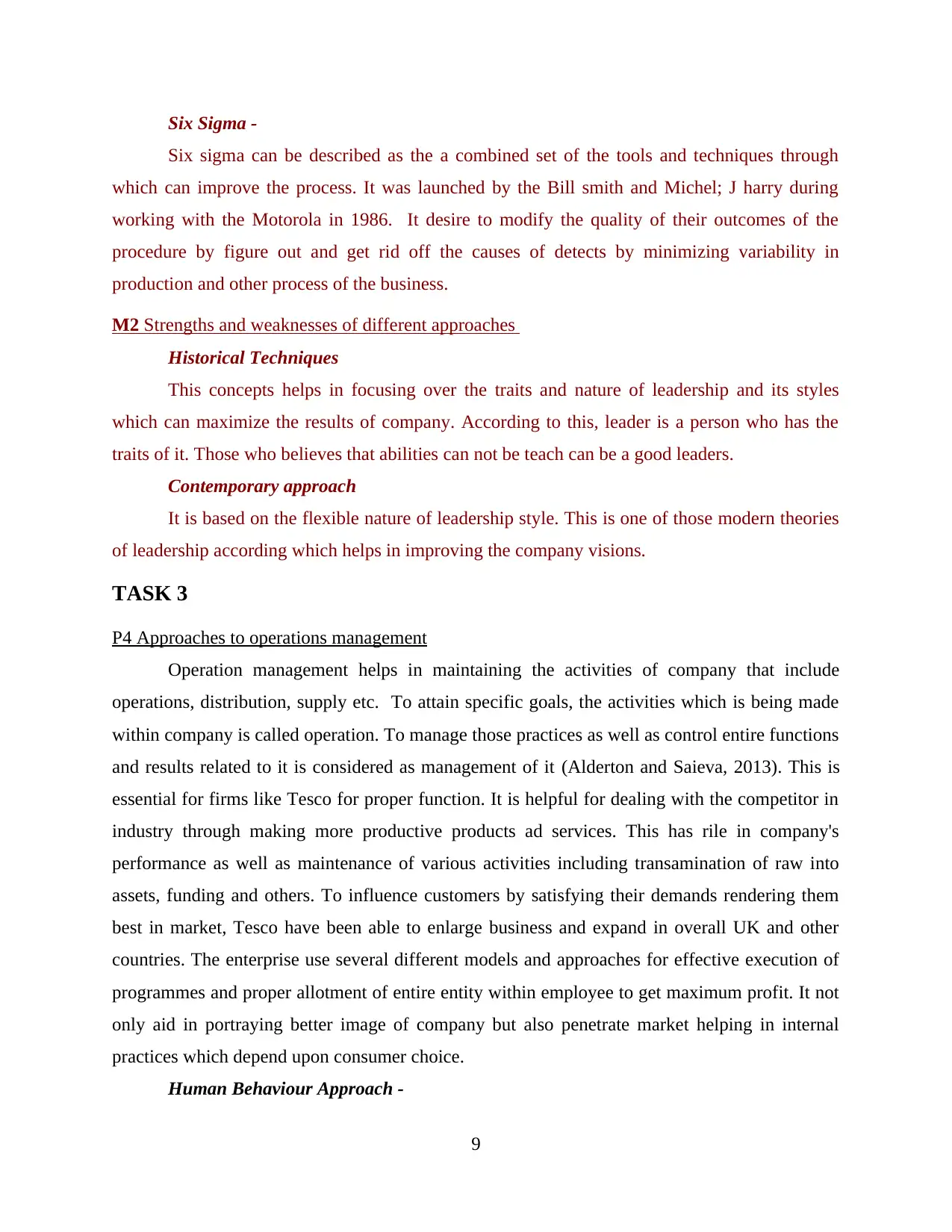
Six Sigma -
Six sigma can be described as the a combined set of the tools and techniques through
which can improve the process. It was launched by the Bill smith and Michel; J harry during
working with the Motorola in 1986. It desire to modify the quality of their outcomes of the
procedure by figure out and get rid off the causes of detects by minimizing variability in
production and other process of the business.
M2 Strengths and weaknesses of different approaches
Historical Techniques
This concepts helps in focusing over the traits and nature of leadership and its styles
which can maximize the results of company. According to this, leader is a person who has the
traits of it. Those who believes that abilities can not be teach can be a good leaders.
Contemporary approach
It is based on the flexible nature of leadership style. This is one of those modern theories
of leadership according which helps in improving the company visions.
TASK 3
P4 Approaches to operations management
Operation management helps in maintaining the activities of company that include
operations, distribution, supply etc. To attain specific goals, the activities which is being made
within company is called operation. To manage those practices as well as control entire functions
and results related to it is considered as management of it (Alderton and Saieva, 2013). This is
essential for firms like Tesco for proper function. It is helpful for dealing with the competitor in
industry through making more productive products ad services. This has rile in company's
performance as well as maintenance of various activities including transamination of raw into
assets, funding and others. To influence customers by satisfying their demands rendering them
best in market, Tesco have been able to enlarge business and expand in overall UK and other
countries. The enterprise use several different models and approaches for effective execution of
programmes and proper allotment of entire entity within employee to get maximum profit. It not
only aid in portraying better image of company but also penetrate market helping in internal
practices which depend upon consumer choice.
Human Behaviour Approach -
9
Six sigma can be described as the a combined set of the tools and techniques through
which can improve the process. It was launched by the Bill smith and Michel; J harry during
working with the Motorola in 1986. It desire to modify the quality of their outcomes of the
procedure by figure out and get rid off the causes of detects by minimizing variability in
production and other process of the business.
M2 Strengths and weaknesses of different approaches
Historical Techniques
This concepts helps in focusing over the traits and nature of leadership and its styles
which can maximize the results of company. According to this, leader is a person who has the
traits of it. Those who believes that abilities can not be teach can be a good leaders.
Contemporary approach
It is based on the flexible nature of leadership style. This is one of those modern theories
of leadership according which helps in improving the company visions.
TASK 3
P4 Approaches to operations management
Operation management helps in maintaining the activities of company that include
operations, distribution, supply etc. To attain specific goals, the activities which is being made
within company is called operation. To manage those practices as well as control entire functions
and results related to it is considered as management of it (Alderton and Saieva, 2013). This is
essential for firms like Tesco for proper function. It is helpful for dealing with the competitor in
industry through making more productive products ad services. This has rile in company's
performance as well as maintenance of various activities including transamination of raw into
assets, funding and others. To influence customers by satisfying their demands rendering them
best in market, Tesco have been able to enlarge business and expand in overall UK and other
countries. The enterprise use several different models and approaches for effective execution of
programmes and proper allotment of entire entity within employee to get maximum profit. It not
only aid in portraying better image of company but also penetrate market helping in internal
practices which depend upon consumer choice.
Human Behaviour Approach -
9
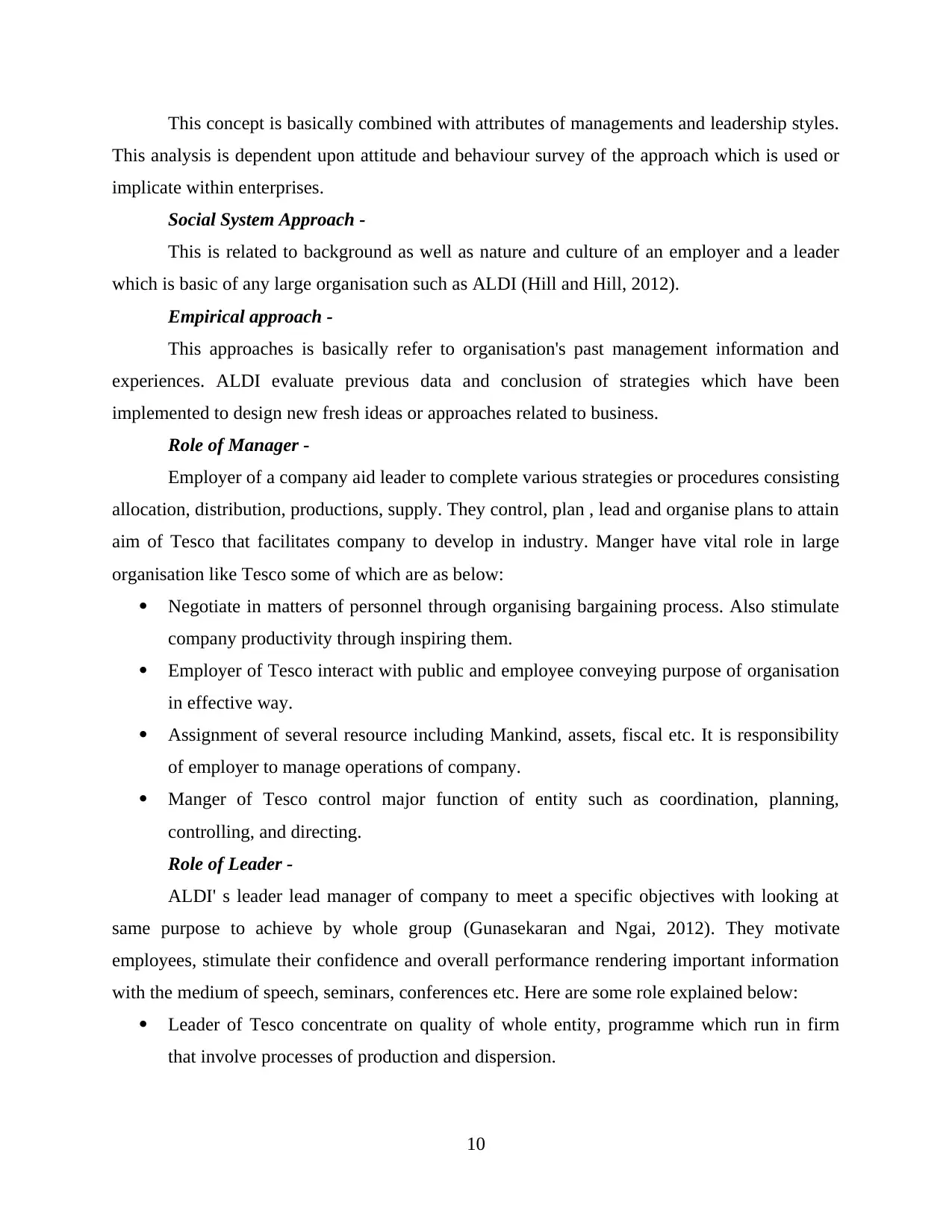
This concept is basically combined with attributes of managements and leadership styles.
This analysis is dependent upon attitude and behaviour survey of the approach which is used or
implicate within enterprises.
Social System Approach -
This is related to background as well as nature and culture of an employer and a leader
which is basic of any large organisation such as ALDI (Hill and Hill, 2012).
Empirical approach -
This approaches is basically refer to organisation's past management information and
experiences. ALDI evaluate previous data and conclusion of strategies which have been
implemented to design new fresh ideas or approaches related to business.
Role of Manager -
Employer of a company aid leader to complete various strategies or procedures consisting
allocation, distribution, productions, supply. They control, plan , lead and organise plans to attain
aim of Tesco that facilitates company to develop in industry. Manger have vital role in large
organisation like Tesco some of which are as below:
Negotiate in matters of personnel through organising bargaining process. Also stimulate
company productivity through inspiring them.
Employer of Tesco interact with public and employee conveying purpose of organisation
in effective way.
Assignment of several resource including Mankind, assets, fiscal etc. It is responsibility
of employer to manage operations of company.
Manger of Tesco control major function of entity such as coordination, planning,
controlling, and directing.
Role of Leader -
ALDI' s leader lead manager of company to meet a specific objectives with looking at
same purpose to achieve by whole group (Gunasekaran and Ngai, 2012). They motivate
employees, stimulate their confidence and overall performance rendering important information
with the medium of speech, seminars, conferences etc. Here are some role explained below:
Leader of Tesco concentrate on quality of whole entity, programme which run in firm
that involve processes of production and dispersion.
10
This analysis is dependent upon attitude and behaviour survey of the approach which is used or
implicate within enterprises.
Social System Approach -
This is related to background as well as nature and culture of an employer and a leader
which is basic of any large organisation such as ALDI (Hill and Hill, 2012).
Empirical approach -
This approaches is basically refer to organisation's past management information and
experiences. ALDI evaluate previous data and conclusion of strategies which have been
implemented to design new fresh ideas or approaches related to business.
Role of Manager -
Employer of a company aid leader to complete various strategies or procedures consisting
allocation, distribution, productions, supply. They control, plan , lead and organise plans to attain
aim of Tesco that facilitates company to develop in industry. Manger have vital role in large
organisation like Tesco some of which are as below:
Negotiate in matters of personnel through organising bargaining process. Also stimulate
company productivity through inspiring them.
Employer of Tesco interact with public and employee conveying purpose of organisation
in effective way.
Assignment of several resource including Mankind, assets, fiscal etc. It is responsibility
of employer to manage operations of company.
Manger of Tesco control major function of entity such as coordination, planning,
controlling, and directing.
Role of Leader -
ALDI' s leader lead manager of company to meet a specific objectives with looking at
same purpose to achieve by whole group (Gunasekaran and Ngai, 2012). They motivate
employees, stimulate their confidence and overall performance rendering important information
with the medium of speech, seminars, conferences etc. Here are some role explained below:
Leader of Tesco concentrate on quality of whole entity, programme which run in firm
that involve processes of production and dispersion.
10
⊘ This is a preview!⊘
Do you want full access?
Subscribe today to unlock all pages.

Trusted by 1+ million students worldwide
1 out of 19
Related Documents
Your All-in-One AI-Powered Toolkit for Academic Success.
+13062052269
info@desklib.com
Available 24*7 on WhatsApp / Email
![[object Object]](/_next/static/media/star-bottom.7253800d.svg)
Unlock your academic potential
Copyright © 2020–2025 A2Z Services. All Rights Reserved. Developed and managed by ZUCOL.





